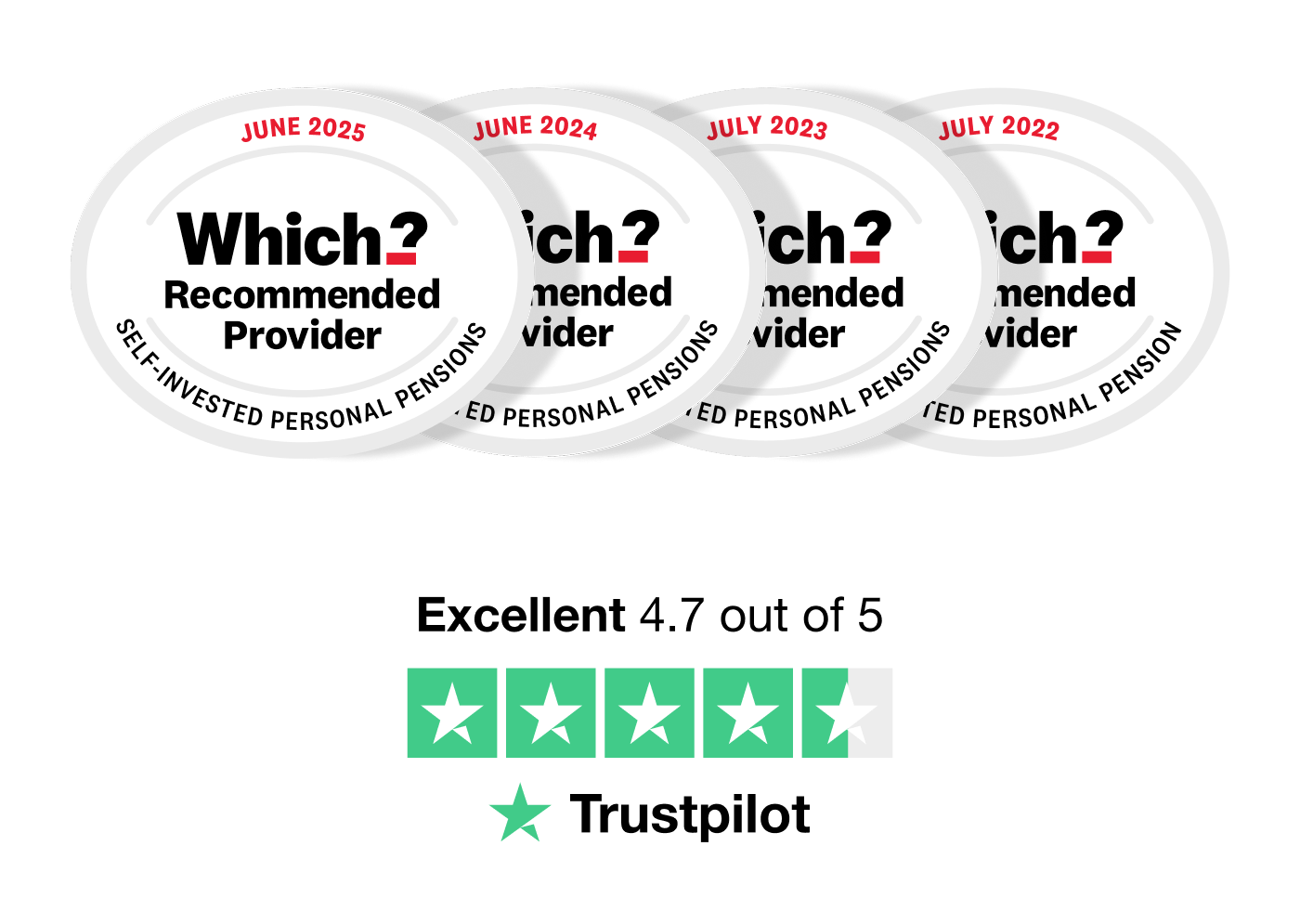Self-employed pensions: options, benefits and tax relief
If you’re self-employed, it’s down to you to save for your retirement. In this guide, we'll go through everything you need to know about self-employed pensions.

What you’ll learn in this guide...
- Why personal pensions are a tax-efficient way for self-employed people to boost their retirement finances
- The personal pension options open to self-employed savers
- How tax relief on pension contributions will boost the value of your pot
- How self-employed savers can tailor their pension contributions to match their cash flow
- Your rights to the state pension and how much you’ll get
Jump to...
- Why set up a pension when you’re self-employed?
- The benefit of pensions when you’re self-employed
- Do the self-employed get a state pension?
- What pension options are available to the self-employed?
- Making pension contributions when you're self-employed
- Important considerations before starting your self-employed pension
- Tips for building a self-employed pension
- How the ii Personal Pension (SIPP) can help you reach your retirement goals
- FAQs
Important information: The ii SIPP is for people who want to make their own decisions when investing for retirement. As investment values can go down as well as up, you may end up with a retirement fund that’s worth less than what you invested. Usually, you won’t be able to withdraw your money until age 55 (57 from 2028). Before transferring your pension, check if you’ll be charged any exit fees and make sure you don't lose any valuable benefits such as guaranteed annuity rates, lower protected pension age or matching employer contributions. If you’re unsure about opening a SIPP or transferring your pension(s), please speak to an authorised financial adviser.
Why set up a pension when you’re self-employed?
If you’re self-employed, you won’t automatically be signed up to a workplace pension. That means it’s up to you to save for retirement.
The state pension provides a safety net, but it’s unlikely to be enough for a comfortable retirement. Without additional savings, you may have to work for longer or compromise on the kind of life you wish to live in retirement.
To protect your lifestyle and keep your retirement options open, you’ll need to save into a personal pension too.
But if you’re self-employed and not paying into a pension, you're not alone. According to the Institute for Fiscal Studies, only one in five self-employed workers earning over £10,000 a year is currently saving in a pension, compared to four in five employees.
The benefits of pensions if you’re self-employed
Pensions offer a powerful way to save for retirement, even without employer contributions, thanks to generous tax benefits that can significantly boost your savings over time.
Let’s take a closer look at these benefits.
Pension tax relief
When you pay money into a pension, you get tax relief on your contributions. This is equivalent to the highest rate of income tax that you pay.
With personal pensions that you arrange yourself, your contributions will automatically get a 20% top-up (basic rate tax relief). But if you pay the higher or additional rate of tax, you may be able to claim an additional 20% or 25% when completing your annual Self Assessment tax return.
This means the cost of investing £1,000 in a pension is just…
£800 for basic rate taxpayers
£600 for higher rate taxpayers
£550 for additional rate taxpayers
Over the years, tax relief makes a huge difference to the growth of your pot and means you get to keep more of the money you’ve worked so hard to earn.
But the way you benefit from tax relief will depend on your business structure:
If you’re a sole trader: Your pension provider will automatically claim 20% tax relief for you. If you’re a higher or additional rate taxpayer, you can claim an extra 20% or 25% by declaring your pension contributions on your Self Assessment tax return. You can contribute up to 100% of your earnings (up to £60,000) each tax year and get tax relief. But, if you’ve already made a taxable withdrawal from a pension or if your adjusted income is over £260,000, lower allowances may apply.
If you’re in a partnership: Business partners need to pay pension contributions from their personal income, just like sole traders (as explained above). Basic rate tax relief is applied automatically but higher and additional rate tax relief can be claimed through your tax return.
If you work for your own limited company: As a limited company director, you also have the option to make pension contributions directly from your company's pre-taxed income. Depending on your circumstances, this could be a more tax-efficient way to pay into your pension as it reduces the amount of corporation tax your business pays. It’s worth talking to your accountant to work out which option makes the most sense for you.
Your money will grow tax-free
When you invest in a pension there will be no tax to pay on either your dividends or your capital gains, meaning you get to keep more of your investment returns.
With the tax burden on investors rising in recent years, this advantage is more valuable than ever. Over time, it can have a significant impact on the size of your pension pot.
Flexible withdrawals and tax-free cash
Once you turn 55 (57 from 2028), you are free to access your pension. But it’s totally up to you how and when you take money out of your pot. For example, you can:
Take up to 25% of your pension tax-free, subject to a maximum of £268,275 unless you have protection in place, even if you don't plan to take the rest until later.
Move your pot into income drawdown and take a tax-free lump sum of up to 25%, subject to a maximum of £268,275, and set up regular or one-off payments for the rest.
Make taxable lump sum withdrawals, also known as Uncrystallised Funds Pension Lump Sum (UFPLS). The first 25% of each lump sum is tax-free, subject to a maximum of £268,275, and the rest is taxed as income.
Choose to buy an annuity. This is where you get guaranteed income in return for some or all of your pension pot.
You don’t need to make a decision straightaway and can use any of these options in different combinations.
You decide how much to contribute and when
A good personal pension will let you decide how much to pay in and when – a feature that’s really important when you’re self-employed.
For example, if your income is relatively stable, you can set up affordable regular monthly contributions. Alternatively, you can make ad hoc lump sum payments into your pension as and when your cash flow allows.
Each tax year, you can pay in 100% of your earnings or up to £60,000 - whichever is lower. If you're a limited company director, you can pay up to £60,000 regardless of income but the contributions must meet the 'wholly and exclusively' requirement to qualify for tax relief. This is the current standard annual allowance, which includes personal contributions, employer contributions and tax relief.
If you've had a good year, you may be able to contribute more using carry forward rules. Carry forward lets you contribute any unused allowance from the previous three tax years.
You decide where your money is invested
A personal pension will also let you decide where to invest your pension wealth – but the options available will depend on the provider you choose.
Many pensions offer ready-made portfolios, featuring funds chosen by experts and managed on your behalf. These can be a great option if you don’t want to spend time making investment decisions yourself.
However, if you want more freedom and control, you should also be able to choose from a wide choice of funds, investment trusts, ETFs, shares and more.
You can either build your own portfolio or invest in one well-diversified fund.
This flexibility means it’s possible to tailor your investment strategy to match your retirement goals and attitude to risk.
Secure a better retirement
Pensions provide a tax-efficient way to save for retirement and can make a real difference to both your lifestyle and the options you’ll have in later life. Whether your priority is to see the world or relax with family and friends, saving into a pension can help make your vision a reality.
Over the years your contributions – which will be topped-up by tax relief – will be invested in the stock market and should start to benefit from compound growth. This is where your investment returns start working for you and earning returns too, boosting the growth of your pension even further.
This is why it’s best to start investing as soon as you can. The sooner you start, the more you’ll benefit from compound growth and the less money you’ll need to save to hit your goal.
Pensions are designed to provide you an income in retirement, but they can also support your loved ones too. When you die, any money that’s left in your pension can be passed on to whoever you choose.
Just be aware that the amount of tax they will pay on the money depends on your age at death. If you die before age 75 there will be no income tax to pay, but if you die after your 75th birthday, your beneficiaries will pay income tax on withdrawals at their highest rate.
Currently pensions can be passed on free of Inheritance Tax (IHT). But from April 2027, they will form part of your estate and could become subject to IHT.
Do the self-employed get the state pension?
The state pension is available to all UK residents – the key is that you make sufficient National Insurance (NI) contributions.
To receive the full State Pension, you need to have 35 years of NI contributions. If you have between 10 and 34 qualifying years, you'll receive a proportion of the full amount. With fewer than 10 years, you won’t be eligible for any State Pension.
You may either pay for NI contributions from your earnings, or receive credits if you have been in receipt of certain state benefits.
The full state pension currently pays £230.25 a week, or £11,973 a year (2025/26).
You can find out whether you’re on track for the full payment by requesting a state pension forecast online.
Find out how much you need overall to retire with our guide.
What pension options are available to the self-employed?
Although the state pension may provide the self-employed with a financial safety net, it’s unlikely to pay enough to deliver a comfortable standard of living - especially if you’ve had a good income during your working life.
The good news is there are several pension options available. They all offer the same tax benefits, but differ in how they’re managed, the choice of investments available and the fees you may have to pay.
The most common options are:
Personal pensions: Typically offered by insurance companies, these pensions normally offer access to a choice of investment funds, although the number of options varies between providers.
Self-Invested Personal Pensions (SIPPs): SIPPs are a type of personal pension that offer savers a wide choice of investments (including funds and shares), flexible contributions and access to all the available retirement income options. But, you need to manage your pension yourself, this includes how and where you invest your contributions.
Other options include:
NEST: Self-employed individuals may also be able to take out a simple personal pension with the National Employment Savings Trust (NEST), a government-backed workplace pensions provider. When considering this provider, make sure to review the fees and investment options.
SSAS: If you’re in a business partnership or are a director of a limited company, you may be able to set up a Small Self-Administered Scheme (SSAS). Unlike other pensions, the fund can be used to invest in the business. SSAS schemes can be opened for the benefit of between one and 11 members. You will need to take professional advice to set up a SSAS.
Workplace pensions: Some contractors that work through an umbrella company will get access to a workplace pension. Many umbrella companies also allow contributions to a SIPP, so it’s worth asking if they offer this option.
Stakeholder pensions: These are personal pensions that were designed to meet certain minimum standards for charges and flexibility, making it easier for lower earners to save for retirement. However, since they were introduced in 2001, personal pensions generally have become more flexible and cheaper to run. Now stakeholder pensions are only available from a limited number of insurance companies.
Making pension contributions when you're self-employed
The sooner you start saving into a pension the better.
The table below shows how much you could have in your pension by age 66, based on when you start saving.
Our calculations are based on a £500 total pension contribution every month, including tax relief, assumes a 5% average return after fees.
Age at which you start saving | Value of pension at age 66 |
|---|---|
20 | £1,076,160 |
30 | £606,261 |
40 | £320,958 |
50 | £147,732 |
55 | £88,618 |
Exactly how much money you will have in your pension depends on the value of your pension contributions and the performance of your investments.
The maximum you can normally pay into your pension is £60,000 a year, which works out at £5,000 a month. But, if you have any unused allowances from the previous three tax years, you may be able to pay in more by using carry forward.
Important considerations before starting your self-employed pension
Here are a few things to think about before you open your pension:
Bear in mind that you won’t be able to access your pension savings until you’re 55 (57 from 2028). This reduces the risk of you dipping into your retirement savings, but it’s important not to tie up money you may need in the short or medium term.
Your money will be invested in the stock market and performance isn’t guaranteed.
If you’re a higher or additional rate taxpayer, you will need to declare pension contributions on your tax return to get your full rate of tax relief.
You'll be responsible for managing your pension, including how much to contribute and where to invest.
Tips for building a self-employed pension
Start saving early – even small amounts will make a big difference over time.
Make pension saving non-negotiable – set up a direct debit or identify key points in your financial year to make lump sum contributions.
Always increase your pension contributions as your earnings rise.
Take advantage of carry forward rules in bumper years to boost your pension contributions.
If you have pensions from previous jobs, think about combining them into one. This makes your savings easier to manage and often lowers your costs. If you’re not sure where all your pots are, our guide on how to find old pensions can help.
Don’t overlook charges when you’re researching pensions. Keeping costs down means you save even more for retirement.
Choose a pension that offers the investment options you want and feel comfortable with.
If you aren’t sure about what’s right for you or your business, it’s worth discussing your options with your accountant or seeking financial advice. You can find regulated advisers near you at unbiased.
Use the ii pension calculator to check if your savings are on track — or see how increasing your contributions could boost your retirement pot.
How the ii Personal Pension (SIPP) can help you reach your retirement goals
Low cost: Most platforms charge on a percentage basis, meaning the more you invest the more you pay. We're different. Our flat fees mean that the more you keep with us, the more you save.
Consolidation: You can use the ii Personal Pension to combine any old pensions into one pot. Every year, thousands of people choose to transfer their pensions to ii from companies like Aviva, Scottish Widows, Hargreaves Lansdown and more.
Choice: We offer a wide range of investment options. More choice doesn’t have to mean more complexity. Our expert picks and SIPP investment ideas can do the hard work for you.
Flexible withdrawals: Unlike some pensions, when you’re ready to start taking an income from your SIPP, you have a range of flexible options to choose from. This includes tax-free cash, income drawdown, lump sums or a combination that best suits your needs.
Top rated service and support: It’s easy to keep track of your pension by using our website and secure mobile app. But, if you’re ever in need of SIPP support you can count on us. We’re happy to say that ii has more 5-star Trustpilot reviews than any other UK SIPP provider.

See how Mark pays less for his pension with ii
“With a lot of providers’ charges, it’s this plus that plus that. Whereas with ii, it’s straightforward. What I pay is what I pay – ii’s fees are just so much cheaper. That’s why I’m with ii.”
Mark, 47, was frustrated with the fees he was paying with his old provider. With ii’s low flat fee, he believes he may be able to retire earlier.

Important information: The ii SIPP is for people who want to make their own decisions when investing for retirement. As investment values can go down as well as up, you may end up with a retirement fund that’s worth less than what you invested. Usually, you won’t be able to withdraw your money until age 55 (57 from 2028). Before transferring your pension, check if you’ll be charged any exit fees and make sure you don't lose any valuable benefits such as guaranteed annuity rates, lower protected pension age or matching employer contributions. If you’re unsure about opening a SIPP or transferring your pension(s), please speak to an authorised financial adviser.
How can Pension Wise help?
If you have a defined contribution pension scheme and are 50 or over, then you can access free, impartial guidance on your pension options by booking a face to face or telephone appointment with Pension Wise, a service from MoneyHelper.
If you are under 50, you can still access free, impartial help and information about your pensions from MoneyHelper.
